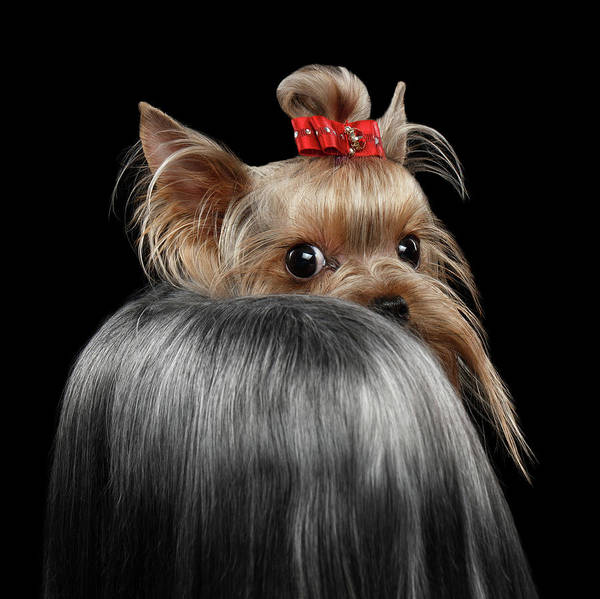
The AKC recognizes four colors pairs for the Yorkshire Terrier:
- Black and tan
- Black and gold
- Blue and tan
- Blue and gold
To our knowledge, Yorkie puppies are typically born with black and tan coat coloring. There may be a slight combination of these two colors which significantly differs from puppy to puppy, but these may not be the dog’s color as a mature adult.
A pup may even be born with a small white spot on the forechest, but it shouldn’t exceed an inch at its longest dimension. Perhaps it is urban legend, but we’ve read that some breeders regard a small white spot as indicative that the puppy will grow a long, full coat in adulthood.
Furthermore, and to be clear, the aforementioned blue in the accepted colors isn’t a precise ‘blue,’ but rather one that is more inky black or bluish-black that almost looks blue in the light. Similarly, gold is simply a richer, shinier shade of tan coloring. But we digress.
Most Yorkies start changing their coat color by the time they are six months old, and the change is slow and so gradual that their owner may not even notice it. Some color changes are age related, but some are due to two specific pigments: eumelanin (black) and phaeomelanin (red). These two pigments combine in different degrees. As puppies, the black, sandy eumelanin is dominant in the Yorkies. However, as a Yorkie ages, his or her genetic composition instructs some of the eumelanin to lighten, develop bluish or silver Yorkie hair.
So how does one choose the color for the dog’s registration papers? We defer to Yorkie owner to advise how they do it, but we did come across a complaint coming from a 19th century writer, P. H. Combs, who objected to puppies earning show awards when their coat “does not fully come in until three or four years old, and the honor of winning such a prize (for a puppy) can therefore be of but little practical benefit to the owner” since the adult dog’s color cannot be exactly predicted.
Color (as well as texture and quantity)is important in this breed, so much so that five paragraphs are devoted to it in the AKC breed standard, and any solid color of combination of colors other than the blue and tan as described are disqualifications:
Coat: Quality, texture and quantity of coat are of prime importance. Hair is glossy, fine and silky in texture. Coat on the body is moderately long and perfectly straight (not wavy). It may be trimmed to floor length to give ease of movement and a neater appearance, if desired. The fall on the head is long, tied with one bow in center of head or parted in the middle and tied with two bows. Hair on muzzle is very long. Hair should be trimmed short on tips of ears and may be trimmed on feet to give them a neat appearance.
Colors: Puppies are born black and tan and are normally darker in body color, showing an intermingling of black hair in the tan until they are matured. Color of hair on body and richness of tan on head and legs are of prime importance in adult dogs, to which the following color requirements apply: Blue – Is a dark steel-blue, not a silver-blue and not mingled with fawn, bronzy or black hairs. Tan – All tan hair is darker at the roots than in the middle, shading to still lighter tan at the tips. There should be no sooty or black hair intermingled with any of the tan.
Color on Body: The blue extends over the body from back of neck to root of tail. Hair on tail is a darker blue, especially at end of tail.
Head fall: A rich golden tan, deeper in color at sides of head, at ear roots and on the muzzle, with ears a deep rich tan. Tan color should not extend down on back of neck.
Chest and Legs: A bright, rich tan, not extending above the elbow on the forelegs nor above the stifle on the hind legs.
There are any number of non-standard colors in the breed, as well as parti-colors including a line called the “California line” – and none are acceptable in a show ring. In the early 1900’s, some breeders tried to promote white Yorkies, as well as silver Yorkies born without any tan. Ernest Hemingway’s grandfather owned such a dog, a white Yorkie named “Tassel” in the early 20th century; there is also said to be documentation of white Yorkies being shown at different state agricultural shows.
These will be discussed in a different post at some point in the future because our sense is that it is a hot topic, and one that requires research!
Image: Closeup Yorkshire Terrier by Sergey Taran is available as fine art, and in home decor and lifestyle items here
